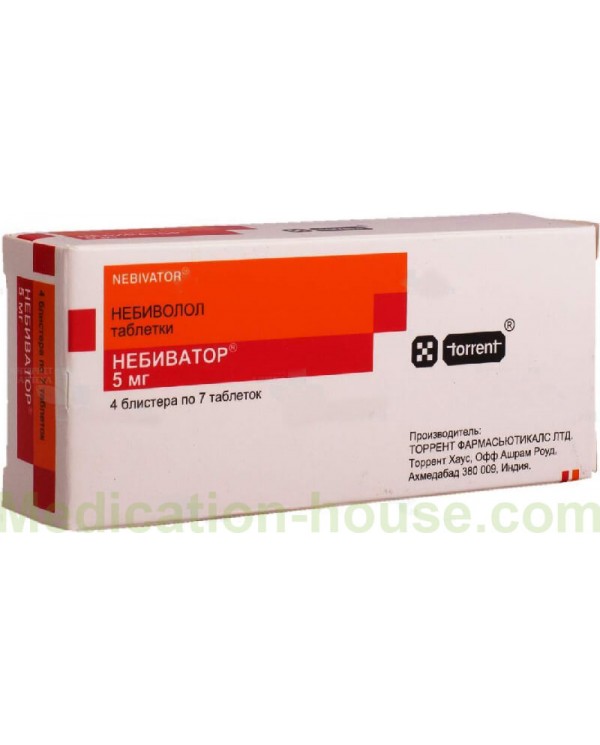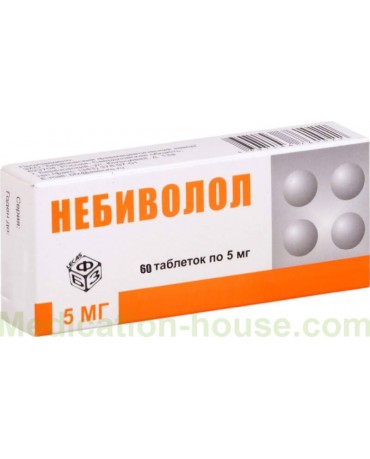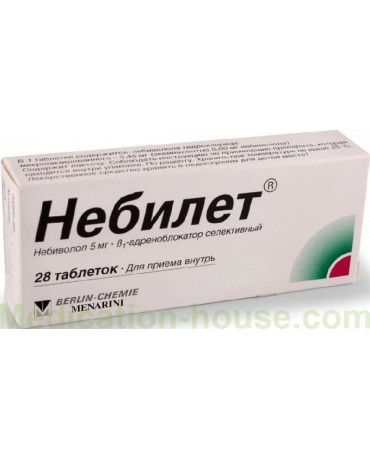Instruction for use of Nebivator
Reed more and buy Nebivator here
Structure
1 tablet contains:
Active ingredient: nebivolol hydrochloride - 5.45 mg, in terms of nebivolol - 5 mg;
excipients: lactose monohydrate 143.475 mg, corn starch 34.5 mg, croscarmellose sodium 13.8 mg, hypromellose 3.45 mg, microcrystalline cellulose 26.45 mg, colloidal silicon dioxide 0.575 mg, magnesium stearate 2.3 mg.
Description
White or nearly white round biconvex tablet with a cross-shaped line on one side.
Pharmacotherapeutic group: Beta1 - selective adrenergic blocker
Pharmacodynamics
Nebivolol is a third generation lipophilic, cardioselective beta1-blocker with vasodilating properties. It has hypotensive, antianginal and antiarrhythmic effects. Nebivolol slows down the heart rate (HR) and lowers blood pressure (BP) at rest and during exercise, reduces left ventricular end-diastolic pressure, improves diastolic heart function, reduces total peripheral vascular resistance, and increases ejection fraction. Competitively and selectively blocks synaptic and postsynaptic beta1-adrenergic receptors, making them inaccessible to catecholamines, modulates the release of endothelial vasodilating factor nitric oxide (NO).
Nebivolol is a racemate consisting of two enantiomers: SRRR-nebivolol (D-nebivolol) and RSSS-nebivolol (L-nebivolol), which combines two pharmacological actions:
- D-nebivolol is a competitive and highly selective blocker of beta1-adrenergic receptors (affinity for beta1-adrenergic receptors is 293 times higher than for beta2-adrenergic receptors);
- L-nebivolol has a vasodilating effect by modulating the release of relaxing factor (NO) from the vascular endothelium.
The antihypertensive effect is also due to a decrease in the activity of the renin-angiotensin-aldosterone system (does not directly correlate with the change in renin activity in the blood plasma). The antihypertensive effect occurs on the 2nd - 5th day of treatment, a stable effect is observed after 1-2 months. This effect persists with long-term treatment. By decreasing myocardial oxygen demand (decreased heart rate, decreased preload and afterload), nebivolol reduces the number and severity of angina attacks and improves exercise tolerance.
The antiarrhythmic effect is due to the suppression of the automatism of the heart (including in the pathological focus) and the slowing down of atrioventricular (AV) conduction.
Pharmacokinetics
Suction
After oral administration, both enantiomers of nebivolol are rapidly absorbed from the gastrointestinal tract. Absorption is not affected by food intake, so nebivolol can be taken with or without food. Bioavailability averages 12% in patients with "fast" metabolism ("first pass" effect) and is almost complete in patients with "slow" metabolism.
Distribution
The connection with blood plasma proteins (mainly albumin) for D-nebivolol is 98.1%, and for L-nebivolol - 97.9%.
Metabolism
It is metabolized to form active metabolites by alicyclic and aromatic hydroxylation and partial N-dealkylation; the resulting hydroxy and amino derivatives are conjugated with glucuronic acid and excreted in the form of O- and N-glucurones. The metabolic rate of nebivolol by aromatic hydroxylation is genetically determined by oxidative polymorphism and is dependent on CYP2D6.
Withdrawal
One week after administration, 38% (the amount of unchanged active substance is less than 0.5%) of the dose of the drug is excreted by the kidneys and 48% through the intestines.
In patients with "fast" metabolism, the half-life (T1 / 2) of nebivolol enantiomers from blood plasma averages 10 hours. In patients with "slow" metabolism, this value increases 3-5 times.
In patients with "fast" metabolism, T1 / 2 of hydroxymetabolites of both enantiomers from blood plasma averages 24 hours, in patients with "slow" metabolism, this value increases approximately 2 times.
The patient's age has no effect on the pharmacokinetics of nebivolol.
Indications
- Arterial hypertension;
- ischemic heart disease: prevention of attacks of stable angina pectoris;
- chronic heart failure (as part of combination therapy)
Contraindications
Hypersensitivity to nebivolol or any of the components of the drug; severe liver failure; acute heart failure; cardiogenic shock; chronic heart failure in the stage of decompensation (requiring intravenous administration of drugs with an inotropic effect); sick sinus syndrome, including sinoatrial block; atrioventricular (AV) block II and III degree (in the absence of an artificial pacemaker); history of bronchial asthma or bronchospasm; pheochromocytoma (without the simultaneous use of alpha-blockers); depression; metabolic acidosis; severe bradycardia (heart rate less than 60 beats / min.); severe arterial hypotension (systolic blood pressure less than 90 mm Hg); myasthenia gravis, muscle weakness; age under 18; lactose intolerance, lactase deficiency or glucose-galactose malabsorption (the drug contains lactose); severe peripheral circulatory disorders (intermittent claudication, Raynaud's syndrome); simultaneous reception with floktaphenin, sultopride (see the section "Interaction with other medicinal products").
Carefully
Renal failure, hyperthyroidism, a history of allergic diseases, psoriasis, AV block I degree, diabetes mellitus, chronic obstructive pulmonary disease, desensitizing therapy, Prinzmetal's angina, elderly patients (over 65 years old).
Pregnancy and lactation
During pregnancy, it is prescribed only according to strict indications, when the benefit to the mother outweighs the risk to the fetus (due to the possibility of delayed development and growth of the fetus, intrauterine fetal death, premature birth, as well as the development of bradycardia in the newborn, lowering blood pressure, hypoglycemia and respiratory paralysis) ... Treatment should be interrupted 48 to 72 hours before delivery. In cases where this is not possible, it is necessary to control the uteroplacental blood flow and fetal growth, as well as ensure strict observation of the newborn during the first three days after delivery. Animal studies have shown that nebivolol is excreted in the milk of lactating animals.
If the use of the drug during lactation is necessary, then breastfeeding should be discontinued.
Method of administration and dosage
Nebivator is taken orally at the same time of day, regardless of food intake, without chewing and drinking a sufficient amount of liquid.
The tablet can be divided into four equal parts at a cruciform risk.
Arterial hypertension (AP and coronary heart disease (IHD):
The average daily dose is 2.5-5 mg of Nebivator (1 / 2-1 tablets of 5 mg) once a day. A clinically significant effect appears after 1-2 weeks of treatment, and in some cases - after 4 weeks. It is possible to use the drug in monotherapy or as part of a combination therapy.
If necessary, the daily dose can be increased to a dose of 10 mg (2 tablets of 5 mg at a time). The maximum daily dose is 10 mg.
In patients with renal insufficiency (creatinine clearance more than 20 ml / min), as well as in patients over the age of 65: the initial dose is 2.5 mg / day (1/2 tablet of 5 mg). If necessary, the daily dose can be increased to 5 mg (1 tablet of 5 mg).
Chronic heart failure (CHF):
Treatment of chronic heart failure should begin with a gradual dose increase until the individual's optimal maintenance dose is reached. Patients should not have had an acute heart failure attack in the past 6 weeks. It is recommended to carry out treatment under the close supervision of a physician.
For patients receiving medical treatment for cardiovascular diseases, including diuretics, digoxin, angiotensin-converting enzyme inhibitors and / or angiotensin II receptor antagonists, the dose of these drugs should be stabilized for the last 2 weeks before starting treatment with Nebivator.
The selection of the dose at the beginning of treatment should be carried out in stages, maintaining 2 week intervals and based on the patient's tolerance to this dose: a dose of 1.25 mg of Nebivator (1/4 5 mg tablet) once a day can be increased first to 2.5-5 mg of the drug Nebivator (1 / 2-1 tablets of 5 mg) once a day, and then up to 10 mg (2 tablets of 5 mg) once a day. The patient should be under the supervision of a physician for 2 hours after taking the first dose of the drug, as well as after each subsequent increase in the dose.
The maximum recommended dose for the treatment of CHF is 10 mg of Nebivator 1 time per day. During titration, regular monitoring of blood pressure, heart rate and symptoms of the severity of CHF is recommended. During titration, in case of worsening of the course of chronic heart failure or drug intolerance, it is recommended to reduce the dose of Nebivator or, if necessary, immediately stop taking it (in case of pronounced arterial hypotension, in case of worsening of CHF with acute pulmonary edema, in case of development of cardiogenic shock, symptomatic bradycardia or AV block).
Treatment of stable CHF with Nebivator is usually long-term. It is not recommended to stop treatment with Nebivator suddenly (if it is not necessary), because this can lead to a transient worsening of heart failure. If necessary, the dose of the drug should be reduced gradually (by half every week).
In patients with mild or moderate renal insufficiency, as well as in patients over 65 years of age, dose selection is not required, since titration to the maximum tolerated dose is carried out on an individual basis.
Side effects
According to the World Health Organization (WHO), unwanted effects are classified according to the frequency of their development as follows:
very often (≥1 / 10), often (≥1 / 100, <1/10), infrequently (≥1 / 1000, <1/100), rarely (≥1 / 10000, <1/1000), very rare (<1/10000, including individual reports), the frequency is unknown (according to the available data, it is impossible to estimate the frequency of development).
From the side of the immune system: the frequency is unknown - angioedema, hypersensitivity;
From the side of the psyche: infrequently - "nightmares", depression; very rarely - hallucinations, psychosis, confusion;
From the nervous system: often - headache, dizziness, paresthesia, weakness; very rarely - fainting;
From the side of the organs of vision: blurred vision, dry eyes;
From the side of the cardiovascular system: very often - bradycardia1, often aggravation of the course of chronic heart failure1, atrioventricular block I degree1, orthostatic hypotension1; infrequently - bradycardia, heart failure, delayed atrioventricular conduction / atrioventricular block, decreased blood pressure, progression of concomitant "intermittent" claudication; very rarely - Raynaud's syndrome.
From the respiratory system, chest and mediastinal organs: often - shortness of breath; infrequently - bronchospasm.
From the digestive system: often - constipation, nausea, diarrhea; infrequently - dyspepsia, flatulence, vomiting.
On the part of the skin and subcutaneous tissues: often - edema1; infrequently - pruritus, erythematous rash; very rarely, aggravation of the course of psoriasis, the toxic effect of drugs of the praktolol group on the eyes, skin and mucous membranes.
Reproductive system disorders: infrequently - erectile dysfunction.
General disorders and disorders at the injection site: very often - dizziness1; often - increased fatigue, edema, drug intolerance1; very rarely - cold snap / cyanosis of the extremities.
1 - in patients with CHF.
Overdose
Symptoms: pronounced decrease in blood pressure, severe bradycardia, AV blockade, cardiogenic shock, acute heart failure, cardiac arrest, bronchospasm, loss of consciousness, coma, nausea, vomiting, cyanosis, hypoglycemia.
Treatment: the patient is hospitalized and placed in an intensive care unit.
Carry out gastric lavage, intake of activated carbon. In the case of a pronounced decrease in blood pressure, it is necessary to give the patient a horizontal position with raised legs, if necessary, intravenous administration of fluid and vasopressors; as a follow-up, it is possible to administer glucagon (50-100 mcg / kg). With severe bradycardia, 0.5-2 mg of atropine is administered intravenously (iv); in the absence of a positive effect, a transvenous or intracardiac pacemaker can be delivered.
In case of AV blockade (II-III grade), it is recommended to introduce intravenous beta-adrenomimetics; if they are ineffective, consider installing an artificial pacemaker. In heart failure, treatment begins with the introduction of cardiac glycosides and diuretics; in the absence of an effect, it is advisable to administer dopamine, dobutamine or vasodilators. In case of bronchospasm, betag-adrenergic agonists are administered intravenously. With ventricular premature beats - lidocaine (class IA antiarrhythmics should not be administered). In case of hypoglycemia, the administration of a dextrose (glucose) solution.
Interaction
Pharmacodynamic interaction With simultaneous use with class I antiarrhythmic drugs (quinidine, hydroquinidine, cybenzoline, flecainide, disopyramide, lidocaine, mexilitin, propafenone), it is possible to increase the negative inotropic effect and lengthen the time of atrial excitation.
With the simultaneous use of beta-blockers with blockers of "slow" calcium channels (BMCC) (verapamil, diltiazem), the negative effect on myocardial contractility and AV conduction is enhanced.
IV administration of verapamil against the background of nebivolol is contraindicated. When combined with antihypertensive drugs, nitroglycerin or BMCC, severe arterial hypotension may develop (special care is needed when combined with prazosin). With simultaneous use with antihypertensive drugs with a central mechanism of action (clonidine, guanfacine, moxonidine, methyldopa, rilmenidine), heart failure may worsen due to a decrease in sympathetic tone (decrease in heart rate and cardiac output, vasodilation). If these drugs are suddenly discontinued, especially before nebivolol is discontinued, withdrawal syndrome may develop.
With simultaneous use with class III antiarrhythmic drugs (amiodarone), it is possible to lengthen the time of excitation through the atria. The simultaneous use of beta-blockers and drugs for general anesthesia can cause suppression of reflex tachycardia and increase the risk of arterial hypotension. The concomitant use of insulin and oral hypoglycemic drugs may mask some of the symptoms of hypoglycemia (palpitations, tachycardia). Concomitant use of nebivolol with cardiac glycosides can cause a slowdown in AV conduction. However, clinical studies of nebivolol found no indication of this interaction. Nebivolol does not affect the pharmacokinetics of digoxin.
Concomitant use of nebivolol and dihydropyridine-type BMCC (amlodipine, felodipine, lacidipine, nifedipine, nicardipine, nimodipine, nitrendipine) may increase the risk of arterial hypotension. An increased risk of further deterioration of ventricular pumping function in patients with heart failure cannot be ruled out.
The simultaneous use of tricyclic antidepressants, barbiturates and phenothiazine derivatives can enhance the hypotensive effect of beta-blockers. No clinically significant interaction between nebivolol and non-steroidal anti-inflammatory drugs (NSAIDs) has been established. Acetylsalicylic acid can be used concomitantly with nebivolol as an antiplatelet agent. With simultaneous use, sympathomimetic agents can suppress the activity of beta-blockers. Active substances with beta-adrenergic action can lead to unhindered alpha-adrenergic activity of sympathomimetics with both alpha and beta-adrenergic effects (risk of hypertension, severe bradycardia and heart block).
The simultaneous use of nebivolol and floctaphenin is contraindicated. There is a threat of a pronounced decrease in blood pressure or shock. The simultaneous use of nebivolol and sultopride is contraindicated. The risk of developing ventricular arrhythmias increases.
The simultaneous use of baclofen and amifostin with antihypertensive drugs can cause a significant drop in blood pressure, therefore, a dose adjustment of antihypertensive drugs is required.
In theory, coadministration of mefloquine with nebivolol can prolong the QT interval.
Pharmacokinetic interaction
The use in combination with drugs that inhibit serotonin reuptake or other drugs that biotransform with the participation of the isoenzyme CYP2D6 (for example, paroxetine, fluoxetine, thioridazine, quinidine) can lead to an increase in the concentration of nebivolol in blood plasma, thereby increasing the risk of developing excessive bradycardia and other side effects. With simultaneous use with cimetidine, the concentration of nebivolol in blood plasma increases without changing the clinical effect. Concomitant use of ranitidine did not affect the pharmacokinetic parameters of nebivolol.
With the simultaneous use of nebivolol with nicardipine, the concentrations of both substances in the blood plasma slightly increase without changing the clinical effect. The simultaneous use of ethanol, furosemide or hydrochlorothiazide does not affect the pharmacokinetic parameters of nebivolol.
Special instructions
Patients with untreated CHF should not be prescribed beta-blockers until their condition is stable. At the beginning of the treatment of CHF, it is necessary to carefully monitor the patient's condition. Sudden discontinuation of beta-blockers is unacceptable; the abolition of beta-blockers should be carried out gradually, within 10 days (in patients with coronary artery disease - 1-2 weeks).
Beta-blockers can cause bradycardia: the dose should be reduced if the resting heart rate drops to 50-55 beats / min and / or the patient develops symptoms suggestive of bradycardia. The drug has no effect on the plasma glucose concentration in patients with diabetes mellitus. However, care should be taken when treating these patients, as Nebivator can mask certain symptoms of hypoglycemia (tachycardia, heart palpitations) caused by the use of hypoglycemic agents.
With hyperfunction of the thyroid gland, the drug masks tachycardia.
When deciding on the appointment of the drug Nebivator for patients with psoriasis, it is necessary to carefully correlate the intended benefits of using the drug and the possible risk of exacerbation of the course of psoriasis.
Beta-adrenal locators can increase the sensitivity to allergens and the severity of anaphylactic reactions.
Patients wearing contact lenses should take into account that with the use of beta-blockers, a decrease in the production of tear fluid is possible.
When carrying out surgical interventions, the anesthesiologist should be warned that the patient is taking beta-blockers.
Application in pediatrics
There are no clinical data on the efficacy and safety of the drug in children under 18 years of age; therefore, it is not recommended to prescribe the drug to this category of patients.
Impact on the ability to drive vehicles
The effect of Nebivator on the ability to drive vehicles and other mechanisms has not been studied.
When taking Nebivator, care should be taken when driving vehicles and engaging in other potentially hazardous activities that require increased attention and speed of psychomotor reactions (risk of dizziness and other side effects).
Release form / dosage
5 mg tablets.
Packing: 10 tablets in a blister of PVC film and aluminum foil. 3 or 10 blisters in a cardboard box along with instructions for use. 7 tablets in a blister of PVC film and aluminum foil. 2 or 4 blisters in a cardboard box along with instructions for use.
Storage conditions
At a temperature not exceeding 25 ° C in a dark place.
Keep out of the reach of children.
Shelf life - 4 years. Do not use after the expiration date printed on the package.
Terms of sell
You don't need a prescription to buy Nebivator.



